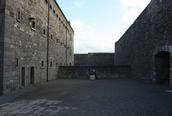
1916 rising
On Easter Monday 1916,
groups of the Irish Volunteers and the Irish
Citizen Army seized the General Post Office
and other strategic locations around the
city of Dublin marking the declaration of an
Irish Republic. The rising failed after one
week and the majority that were involved,
men and women, were arrested and imprisoned
in Kilmainham. The leaders of this rising
were court-martialled, sentenced to death
and spent their last hours in Kilmainham
before facing the firing squad here, in the
stone-breaker’s yard of the gaol.
|
 The War of Independence and The Civil War The War of Independence and The Civil War
With the release of those
that were imprisoned in Britain for their
part in the 1916 Rising and after the
forming of the Irish parliament, the Dáil,
the first shots of the War of Independence
were fired. The war, fought through
guerrilla warfare, between the Irish
Republican Army and the British forces took
place from 1919 until the declaration of a
Truce in July 1921.
With the truce of 1921,
it led to what is known as the Anglo-Irish
Treaty being signed. The six county state of
Northern Ireland came into being, with the
other twenty-six counties becoming the Irish
Free State. Disagreement arose on whether to
accept this agreement in addition to having
to swear an oat of allegiance to the British
crown, whom would remain Head of State. A
split occurred through the then government,
where half opted to support the treaty
pro-Treaty, or Free State and the remainder
felt that the treaty was not good enough and
should be rejected, the anti-Treaty, or
Republican side. These two sides broke out
into Civil War in June 1922 and the Free
State Army began to run the gaol. The Civil
War ended in 1924, which coincided with the
closing of the gaol in the spring of the
same year.
|